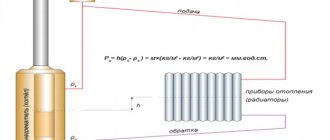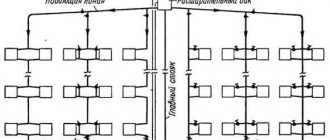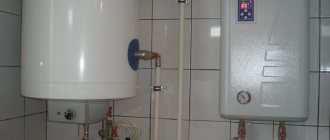Where to begin
Let's start with the legal framework. It is necessary to clearly know what the legislation says about disconnecting from the central heating system and installing an individual one. Often the local administration, referring to Art. 190 Federal Law , refuses to residents. In court, such a refusal will be considered unfounded. In Russian legislation, in addition to Federal Law No. 190 “On Heat Supply,” there is Government Decree No. 307 of April 16, 2012, which considers the procedure for connecting heat supply systems. It specifies a list of individual sources of thermal energy that do not meet certain requirements and are for this reason prohibited for installation in apartment buildings.
This means that the law does not prohibit the use of individual heating using modern heating boilers that meet the specified requirements.
This issue has been considered more than once by courts of general jurisdiction. Refusal of local governments based on Art. 14 of the Federal Law “On Heat Supply” is declared illegal.
Required documents
Thus, in order to refuse the central heating service and switch to individual heating, it is necessary to collect a package of documents in accordance with Art. 26 of the Housing Code of the Russian Federation on the reconstruction of residential premises.
The package of documents includes:
- application for reorganization;
- technical passport of the premises;
- title documents for housing (originals or copies certified by a notary);
- residential renovation project,
- consent of all family members, submitted in writing;
- conclusion of the authorities for the protection of architectural monuments on the possibility of reconstructing the premises.
Documentation for gas heating
The management company, after reviewing the application, provides a letter of permission to disconnect your apartment from central heating. This letter is necessary to order technical conditions (TU) for the installation of individual heating. If you plan to connect gas (install a gas boiler), you must contact the gas service.
Technical conditions are issued within ten days. In case of refusal due to lack of “technical possibility”, keep in mind that such a response is only permissible in regions where there is no gas and it is not possible to purchase it in cylinders.
After purchasing a certified boiler, you should contact the design organization. She will prepare a project for installing a boiler, taking into account technical conditions and capabilities.
Then a project is made to disconnect from central heating in the heat supply organization. The basis for this will be a letter from the HOA with permission to disconnect. It is important to receive a written response. In case of disagreement, it will be possible to go to court.
Having received the project documentation, we go with it to the local branch of the All-Russian Voluntary Firefighting Society (VDPO). There you will be given a fire safety certificate for the project. If necessary, a design is made for the chimney.
Then all documentation is approved by the administration. The conclusion on approval (or refusal) is accepted within 45 calendar days. Refusal to renovate the premises occurs on the basis of Art. 27 of the Housing Code of the Russian Federation (case of failure to submit all documents). The refusal can also be appealed in court.
This is the basic diagram of how to prepare a project and legalize the transition to autonomous heating. The list of all documents may differ in different regions. More accurate information will be given to you directly from the administration of your district.
Preparation of documents for the installation of autonomous heating
The first 50% of success in arranging autonomous heating in an apartment consists of paperwork and going through many bureaucratic delays. To make your task easier, we have compiled approximate step-by-step instructions on how to prepare the necessary papers and coordinate all the work.
Arrangement of autonomous heating in the apartment
Step 1. Collect a package of documents that you will need to obtain permission to disconnect from the centralized heating supply and install autonomous heating:
- technical passport for the apartment:
- documents confirming the ownership of housing or their notarized copies;
- consent to the redevelopment of all those living in the apartment;
- application for disconnection from centralized heating;
- application for redevelopment of an apartment.
Apartment passport
Sample title page of a technical passport for an apartment and what is described below
Step 2. Find out who owns the heating system. If it is communal, then to disconnect from it and connect autonomous heating you will need to obtain the written consent of all residents of the house.
You may be interested in information - heating oil boiler
Step 3. Contact the management company (or HOA) with an application for disconnection from centralized heating and other documents.
HOA
Step 4. Within ten days, you must obtain permission to disconnect from the general heating network and technical specifications (abbreviated as TU) for the heating boiler and autonomous heating system.
Important! If the management company refuses you permission, find out the reason. If it is unfounded, challenge this decision in court. Remember, you have the right to autonomous heating in your own apartment.
Step 5. With technical specifications and other documents, contact a specialized organization that will draw up a project for an autonomous heating system. They must also determine whether you have the technical ability to install such a system and whether this will not harm the other residents, the building itself and its utilities.
Plan for autonomous heating in a three-room apartment with parallel pipe distribution under the floor. You will notice that the exact number of sections of each radiator inside the housing is indicated
Step 6. Submit the application for redevelopment along with the project, technical calculations and other documents to the local government authorities. Within 45 days they must issue you permission to install autonomous heating.
Step 7. If you intend to install a gas boiler, coordinate this event with the gas service in your city.
You may be interested in information about what a coolant is
Step 8. If necessary, confirm with the fire department that your redevelopment project meets all codes.
Some bureaucratic aspects of paperwork and permission for autonomous heating in an apartment may differ in different regions. Please check these points with your local administration in advance.
In addition to the fact that installing autonomous heating is not cheap at all, you must obtain special permission. This is where great difficulties arise
Important! Remember that any unauthorized work that is not agreed upon with the gas service and management company is unacceptable. First, such conditions create a risk for you, your family and neighbors. Secondly, this threatens problems with the law, courts, fines and an official requirement to dismantle autonomous heating in the apartment.
How to make a calculation
A comfortable temperature in the apartment will be maintained if the heating system is installed correctly. To do this, it is necessary to accurately make all calculations, which will depend on the area of the room (S) and the boiler power (W) per 10 m². It is also necessary to take into account the climatic features of the region.
For example, for the Moscow region the power density ranges from one to one and a half kW; in the northern regions - from one and a half to two kW; in the southern regions - from 0.7 to one kW. The power of the heating boiler is calculated using the formula: cat. = SW beat / 10. This simple calculation will help you choose the boiler needed for your apartment.
Heating calculations also depend on the design and type of heating system. The best option for an apartment is a two-pipe system. It is more complex and more expensive than a single-pipe system, but the heating quality will be higher. All batteries, from the first to the last, will heat up evenly. The single-pipe system is only suitable for a small number of radiators.
Boilers for individual gas systems
Boilers that use mains gas are the most practical option for installing an autonomous heating system in a city apartment, provided that the power is selected correctly. We recommend that you familiarize yourself with an example of calculating the power of a gas boiler.
The units are distinguished by a high level of efficiency, operate reliably in intensive use and serve their owners for a long time.
If the cubic capacity of the apartment allows it, you can equip the gas autonomous system with a storage boiler. This will make it possible to store a decent amount of hot water and allow, if necessary, to take a shower and wash dishes at the same time
Modern models are equipped with a closed combustion chamber, convenient electronic ignition and a programmable thermostat. Extensive functionality helps maintain a suitable coolant temperature in the system around the clock, reducing or increasing it as needed.
Features of single-circuit devices
Single-circuit gas boilers operate only for heating. They do not have the function of providing housing with hot water. In order to be able to not only live in a warm room, but also use hot water in the required volume, customers purchase additional capacious tanks with a built-in heat exchanger (indirect heating boiler) and connect them to a gas boiler.
Single-circuit products are floor and wall-mounted. Floor-standing units have an impressive volume and weight, and “eat up” a large amount of usable space. That is why owners of small apartments prefer wall-mounted boilers that do not take up much space.
How to make gas heating for a private house with your own hands
Do-it-yourself installation of autonomous heating is quite within the capabilities of a person who has the skills to do such work. Various installation schemes are considered in detail, attention is paid to individual details.
You can do all the work on installing a home heating system yourself, except:
- connecting the home heating system to the gas network;
- designing gas heating at home.
Insertion and design are performed only by specialized licensed organizations.
Work order
The operating principle of water heating is as follows: water heated by a gas boiler circulates naturally or forcedly through pipelines, giving off heat to the premises. The optimal heating scheme for a two-story private house includes a system with heated floors on the first floor and radiator heating on the second floor. Coolant circulation can be natural (gravity flow) or forced (circulation pump).
Let's consider the procedure for installing autonomous gas heating using the example of a 2-story building:
- installation of a boiler in the boiler room on the first floor;
- installation of a safety group, expansion tank, circulation pump
- installation of a pumping and mixing unit for heated floors to circulate the coolant at the required temperature;
- installation of a manifold for heated floors;
- laying heated floors (specifications of materials and work procedures can be found on the Internet);
- installation of radiators and connecting them to the collector in all rooms of the second floor;
- Upon completion of the complete heating installation, the heated floor is poured with concrete.
Heating schemes for a private house with a gas boiler can be of two types:
1. Single-circuit heating circuit for a private house with a gas boiler (closed, designed only for heating premises)
2. Double-circuit circuit using a special boiler (simultaneously heating and heating tap water)
Autonomous heating wiring diagrams
Heating distribution from a gas boiler is based on several standard heating schemes, which differ in the type of circulation of the coolant (usually water) and in the methods of piping. There are the following types of heating installation:
- Single-pipe heating distribution, in which the pipes are looped and the radiators are arranged in series. The coolant leaving the boiler passes through each radiator in turn. The temperature of the coolant decreases as it moves. It is primitive and imperfect, since the coolant temperature drops towards the end of the cycle.
- The Leningradka system with dedicated bypass radiators is intermediate and eliminates some of the problems of a single-pipe scheme;
- Improved Leningradka system with shut-off and balancing valves;
- Two-pipe wiring consists of supply and return pipes running parallel to each other. Allows the coolant spent in the radiator to be returned to the boiler for heating. The coolant is supplied to the radiator according to this scheme without heat loss.
- Radial (collector) wiring distributes the collected coolant among individual radiators. The scheme is complex and rarely used.
Heating schemes for a 2-story private house can be as follows:
1. Open type heating system
The expansion tank is an open container with an inlet pipe connected to the supply riser. It is installed at the highest point of the heating system - the coolant does not overflow outside, and the expansion tank additionally acts as an air vent.
Scheme of autonomous gas heating of open type
Gas heating
Typically, apartment owners have a choice between two types of alternative heat resources:
- structures based on a gas boiler;
- electric heating systems.
Gas heating has a number of advantages:
- modern boilers are equipped with a high security system and operate autonomously;
- the level of heat that residents need is maintained;
- such installations are small in size, so they can be installed in small rooms;
- The gas boiler is easy to install. With some tools and a little skill, any beginner can do this;
- Autonomous gas heating in the apartment has a chimney system; it does not have to be installed separately.
- the boilers operate silently, so they will not cause complaints from neighbors;
- low cost and complete set of all components and elements make gas heating accessible to consumers.
When installing a new heating system, the old system must be dismantled. It is easier and cheaper to install new radiators than to try to fit old ones to it. Although modern gas installations have a high level of protection, gas leaks can occur.
Choosing pipes, boiler and radiators
The operation of the entire system depends on the correct choice of boiler. For example, if you need to install a boiler to heat water, you can choose a single-circuit gas boiler. If you choose gas heating, it is better to buy a unit made of cast iron or special durable metal. Even though the boiler will be heavy, it will last a long time.
We recommend: How to choose an alternative to central heating in an apartment?
But the pipes for such a heating system are polypropylene or metal-plastic as a budget option and copper if the budget is not limited. You also need to choose radiators in advance. Today, bimetallic heating radiators are very popular among users.
You can determine which radiators are best installed in an apartment based on their heat output, for example: before purchasing radiators, you must first calculate the number of sections for each room. To do this, the heat transfer of the material is divided by 100. For example, for a bimetallic radiator it is 199 W/100, resulting in 1.99 W per 1 square meter.
There are several points to consider when choosing radiators and calculating their number:
- if you install batteries in a corner room, then you need to add 2-3 sections to the results obtained when calculating;
- when installing decorative panels that hide batteries behind them, heat transfer is reduced by 15%, this also needs to be taken into account before making calculations;
- insulated walls or metal-plastic windows reduce heat loss;
- Installing a meter allows you to independently control gas consumption.
Once you do the calculations and add to them the price of the self-contained gas system itself, you can think about purchasing.
Electric boiler for autonomous heating
An alternative to gas-powered equipment can be an electric heating boiler. Unlike the previous option, it is safer, but the cost of its operation will be higher. But in the future, electric heating boilers can compete equally with gas-powered products. Another advantage of such devices is the wide range of possibilities for regulation, including the ability to set different temperatures for each individual room in the apartment. You can read what electric convectors are in our article.
Electric boiler design
Important! Separately, it is worth highlighting combined heating boilers - devices that can heat water for the supply line using both gas and electricity. They cost more than standard boilers, but for the increased price you get versatility and complete autonomy of the apartment heating system.
Types of autonomous heating systems
Electric heating
Autonomous heating based on electric heating boilers has a number of advantages, among which the following points must be noted:
- equipment reliability;
- relatively affordable cost of the boiler;
- noiseless and harmless operation;
- the ability to install and connect equipment on your own.
Electric heating
Modern heating elements included in the design of heating boilers last more than 15-20 years. In addition, modern heating equipment has the ability to program the operating mode and basic system parameters.
Prices for popular electric boilers
Electric boiler
For example, the owner can program the boiler to turn on and off at certain times, which is very convenient. To implement this function, air temperature sensors are used.
Modern electric boiler
As a result, autonomous heating, designed and equipped on the basis of an electric heating boiler, will be able to operate without owner intervention for weeks, or even months. It is this moment that defines the meaning of autonomy.
A full-fledged autonomous system must be able to maintain the temperature at a given level, regardless of the weather outside the window.
Electric boiler wiring
However, electric heating has two significant disadvantages, namely:
- the system requires a stable power supply, and this is not present in all populated areas. Electricity surges and sudden outages can lead to failure of the heating boiler;
- relatively high electricity tariffs. It is this moment that most often stops owners who are determined to install electric heating from realizing their ideas.
Gas heating
Gas heating
One of the most popular options. Provides the most economical heating due to the relatively low price of gas. Such heating has no other significant advantages.
The most common gas heating schemes for a country house
There are many more disadvantages. Among them, the following points deserve special attention:
- equipment hazards;
- high cost of heating boilers;
- the need for regular maintenance by professionals.
In addition, the installation of a gas boiler and the arrangement of full-fledged autonomous heating based on it can only be handled with special skills. To install such a boiler, you need to invite specialists, having previously obtained a number of permits from the relevant authorities.
Prices for popular gas boilers
A gas boiler
Gas heating
And gas pipelines are not installed in all populated areas. If there is no possibility of connecting to the main line, you don’t have to think about autonomous heating based on a gas boiler.
Oil heating
Condensing liquid fuel heating boiler
Liquid fuel boilers are absolutely not suitable for arranging permanent autonomous heating. Limitations are imposed both by the characteristics of the heating equipment itself and the fuel used.
Liquid fuel boilers
Also among the significant disadvantages of such systems is their electrical dependence and fire hazard. Therefore, liquid fuel heating systems can be considered exclusively as a backup and temporary heat source.
Solid fuel heating
Solid fuel heating
One of the most ancient and widespread heating options. The modern market offers a large selection of solid fuel boilers suitable for installing autonomous heating.
Prices for popular solid fuel boilers
Solid fuel boiler Lemax
The main advantage of such equipment is the efficiency of operation due to the relatively low cost of energy.
Solid fuel heating
Disadvantages include the need for dedicated fuel storage space and the need for constant monitoring and maintenance.
Find out which are the best long-burning solid fuel boilers from our new article.
Installation recommendations
Any homeowner may have a natural question regarding electric heating. Why install a boiler and fence pipes with radiators when you can lay cable heated floors or install heating around the perimeter of the rooms using baseboard convectors? The argument in favor of the water system is one, but important: it can be connected to any heat source. For example, tomorrow the electricity tariff will rise, and you have a heating circuit made of cable mats, it is impossible to switch to another energy source.
Another tip is that when organizing a new heating system, it is better to replace the radiators as well. But before you start installing autonomous heating, you need to properly disconnect them from the risers. To do this, the battery is dismantled along with the bypass, and a piece of pipe of the same diameter as the riser is inserted into the resulting gap.
The operation is performed with a steel pipe using welding or a metal-plastic pipe with threads and press fittings. Since wall-mounted boilers always have a built-in circulation pump, a single-pipe system with no more than 5 radiators is suitable for heating a small one-room apartment with an area of 35-40 m2.
If the living area is larger, then for your own convenience it is recommended to make a two-pipe system with lower wiring. As an example, a diagram of an autonomous heating system combined with hot water supply is shown below:
Advantages and disadvantages of autonomous gas heating
From the point of view of economy and efficiency, gas boilers are by far the most profitable heating devices. Comparing the operation of a gas boiler with an electric heating device of similar power, the first option looks preferable. After installing an autonomous gas heating system, the investment pays off within 2-3 years of operation.
According to its technical characteristics, an autonomous gas heat-generating boiler is capable of solving a whole range of problems at the household level. The boiler will not only quickly and efficiently provide the required temperature inside the house, but also provide hot water for domestic purposes. In many respects, a natural gas heating boiler is best suited for autonomous heating of private homes.
Let's take a closer look at the advantages of natural gas heating technology:
- natural gas has one of the highest heat transfer coefficients;
- the low inertia of gas boilers ensures rapid heating of the coolant;
- availability and low cost of natural gas;
- heat generating equipment equipped with automation is capable of operating without human presence;
- various designs and types of gas boilers are capable of efficiently heating both small residential premises and large objects;
- gas, unlike fuel oil, oil, firewood or coal, is an environmentally friendly type of fuel;
- modern models have a high degree of reliability and are designed for long service life.
The list can be continued if we move on to numbers and calculations, however, gas boilers also have some disadvantages, which can rather be called subtleties of operation and design features.
Installation of a gas boiler and the entire heating system in the house is carried out only by specialists with appropriate qualifications. The installation of boiler equipment is preceded by a lengthy procedure for obtaining permission for autonomous gas heating.
Note: Before starting installation, you must have a ready-made heating system project in hand, which must contain all the necessary data and calculations. The project must be carried out in accordance with existing SNiPs and GOSTs. Only an agreed project that has received the approval of the energy company is put into operation.
The gas heating system imposes special requirements on the owners of private houses, compliance and implementation of which guarantees the efficient operation of heating equipment and the safety of the residential property.
Pros and cons of autonomous heating in an apartment
How advisable is it to refuse centralized heating in an apartment building? Let's start with an overview of the benefits that an autonomous heating system in an apartment can bring to you.
- Saving. By giving up centralized heating and switching to heating your apartment yourself using a boiler, you will save yourself from having to pay for many things that were not directly related to maintaining a comfortable temperature in your home. This is the maintenance of heating mains, the operation of boiler houses, energy losses during transmission from the thermal power plant to the end consumer and many other expense items that influenced the amount in the receipt. Instead, you will only pay for the fuel consumed by the boiler.
Autonomous heating has many advantages
- Possibility of regulation . One of the most important advantages of autonomous heating is that you are free to change its power and, consequently, the temperature in the apartment. Do you like cool weather? Reduce boiler power. There is severe frost outside and all your neighbors connected to central heating feel it? But this is not a problem for you - you just need to adjust the boiler and radiators accordingly. With an autonomous heating system, your apartment will always have a comfortable temperature.
- Partial autonomy . Having disconnected from centralized heating, you no longer experience its “whims”. Planned and unscheduled outages related to pipe repairs or accidents on the heating main no longer concern you. Yes, there remains a vulnerability in the form of dependence of your heating system on electricity and gas. But the first can be solved by installing backup batteries, and the second can hardly be called a problem - gas outages are very rare in cities.
- The ability to significantly reduce energy consumption for heating the room due to proper thermal insulation of walls, windows and balcony doors. With centralized heating, this is more difficult to do, since you are not the one who chooses and regulates the temperature of the water in the radiators.
Autonomous heating allows you to save money
Important! When changing the power of the heating boiler, follow the known limits. Do not reduce the room temperature to values that are less than the figures prescribed in building codes. Otherwise, you will “freeze out” neighboring apartments, which can lead to unwanted conflicts with neighbors.
Autonomous heating system installed in the apartment during major repairs and redevelopment. You can notice that the supply and return pipes are laid along the ceiling - then they will be closed
Diagram showing the autonomous heating system in an apartment. The boiler receives fuel from a gas supply line equipped with shut-off valves and a meter. It is also connected to a cold water supply - a double-circuit boiler, and, in addition to heating the apartment, supplies residents with hot water. In the diagram you can see that the cold water line going to the heater is equipped with a filter - its presence significantly extends the service life of the equipment. Of course, the “supply” and “return” of the heating system also depart from the boiler, through which water flows to the radiators and the “warm floor” system
It should be understood that independent heating of an apartment has its own disadvantages and problems. If you are going to install autonomous heating at home, be sure to familiarize yourself with them so that they do not become an unpleasant surprise for you in the future. You can find out what the standard water pressure in the water supply in an apartment should be in our article.
- The first problem that stops many who want to install autonomous heating in their apartment is the need for significant initial investments. A gas boiler, ventilation system, new radiators and pipelines are expensive, but they also need to be installed and connected, which also requires expenses. Of course, autonomous heating in an apartment will pay for itself over time, but this may take you 2-3 or even more years. Are you ready to wait?
- The second problem of autonomous drowning has already been indirectly mentioned above. We are talking about a rather complex and labor-intensive process of installing a heating boiler and all communications.
- A disadvantage of such a heating system is that a double-circuit gas boiler in an apartment can become a potential source of fire. Therefore, its installation and connection to the fuel supply is an extremely important process that requires the services of a qualified specialist who will not make an unfortunate mistake that could subsequently result in an unpleasant incident.
Boiler room in an apartment building
- It should also be understood that an autonomous heating system that includes a gas boiler will require a separate chimney or other ventilation system - standard communications in an apartment building are unlikely to be designed for this.
- And finally, it is worth mentioning that a significant part of the problems with an autonomous heating system is related to the fact that your intentions may meet resistance from neighbors, the gas service and the service company responsible for the condition of the apartment building and providing you with the corresponding services. Therefore, before arranging independent heating, it is extremely important to familiarize yourself with the legal side of the issue.
You may encounter resistance from the gas service and service company
Now, having familiarized ourselves with the positive and negative sides of autonomous heating, we will tell you how to make it. The entire process can be represented as several steps performed sequentially.
- Work with documents - obtaining permission to disconnect from the centralized heat supply and install your own, autonomous system.
- Selecting the power of the heating system for your apartment.
- Choosing a boiler for autonomous heating
- Installation work - installation of meters and boiler, laying pipes, etc.
Competent work with documents is half the success
In the following sections of this article we will look at all these steps, but in more detail. So let's get started.
You may be interested in information - heating convector
Price issue
The cost of installing an individual heating system depends on the size of the apartment, the choice of materials, boiler, pipes, and heating scheme (one-pipe or two-pipe). So, for example, in Moscow you will have to pay at least 2000 USD It all depends on the complexity and volume of work.
So, installing an autonomous heating system will allow you to significantly save on paying for housing and communal services. At the same time, for less money you can create the greatest comfort in your apartment.
Pipes and radiators
When choosing pipes and radiators, the buyer is guided not only by the price indicator and technical characteristics, but also pays attention to the attractive appearance of the models. The aesthetic factor is of particular importance in this case, because these elements are installed in all rooms that will be heated.
Shut-off valves
Autonomous gas heating in many cases turns out to be much more profitable than other heating methods, if you provide for the installation of automation. These mechanisms help control fuel consumption, room temperature and pressure in the boiler. As a result, significant optimization of operating costs of the entire system is achieved. Most manufacturers offer boilers already equipped with automated control capabilities.
Regulation and control devices
Thanks to the controls, working with heating equipment is greatly simplified. It can switch between modes on its own, and if the gas runs out or the wick blows out, the supply will be shut off. Automation makes it possible to program on and off. And, of course, you can forget about fussing with matches and lighters, because a piezoelectric element is provided for ignition.
An ideal heating system certainly cannot do without a circulation pump. This device can increase its efficiency to a significant extent. It serves to provide the necessary coolant pressure so that it moves faster through the pipeline. Thus, the system warms up faster, and the temperature throughout the home increases evenly. This is especially true for large houses.
Advice. In an effort to save on costs, don't do so at the expense of equipment. Choose quality devices from reliable suppliers. The real cost savings in the long term will come from insulating your entire home by installing leak detectors and using good fuel.
Gas autonomous heating is a reasonable solution in conditions of inaccessibility of centralized supply. The system, designed and installed by specialists taking into account all the nuances, will safely and efficiently heat your home.
Advantages and disadvantages
If you have received permission for autonomous heating in an apartment building, then you can choose an alternative option. This is easy to do if you know its advantages and disadvantages. For the first time, an autonomous housing heating system arose in Europe. Thanks to its striking advantages over centralized space heating options, it quickly became popular around the world.
Advantages of alternative apartment heating:
- significant cost savings;
- The owner of the apartment decides when to turn the heating on and off. For example, today there are thermostats in which you can set a timer for a specific time, which allows you to completely or half turn off the system when no one is home, and turn it on 30 minutes before the arrival of residents;
- the owner of the apartment can create the necessary microclimate in each room;
- the ability to pay only using the heating meter and not depend on utility companies and government tariffs;
- When choosing alternative heat, you must first find out the cost of autonomous heating in the apartment and which model will be not only economical, but also effective.
We recommend: What alternative heating options exist for a private home without gas or electricity?
Among the disadvantages of such a system are the following:
- continuous preventive check of the system once a year with a call to a specialist. This is inexpensive, but still many consumers either ignore this need or forget about it;
- If you install even the best heating radiators, you must not forget about possible heat losses caused by external walls, rooms not heated from below, and poor-quality glazing.
Today, many construction companies are building multi-storey buildings with ready-made autonomous heating systems. Such housing is in great demand because it is cheaper and allows apartment owners to decide for themselves which type of heating to choose.










